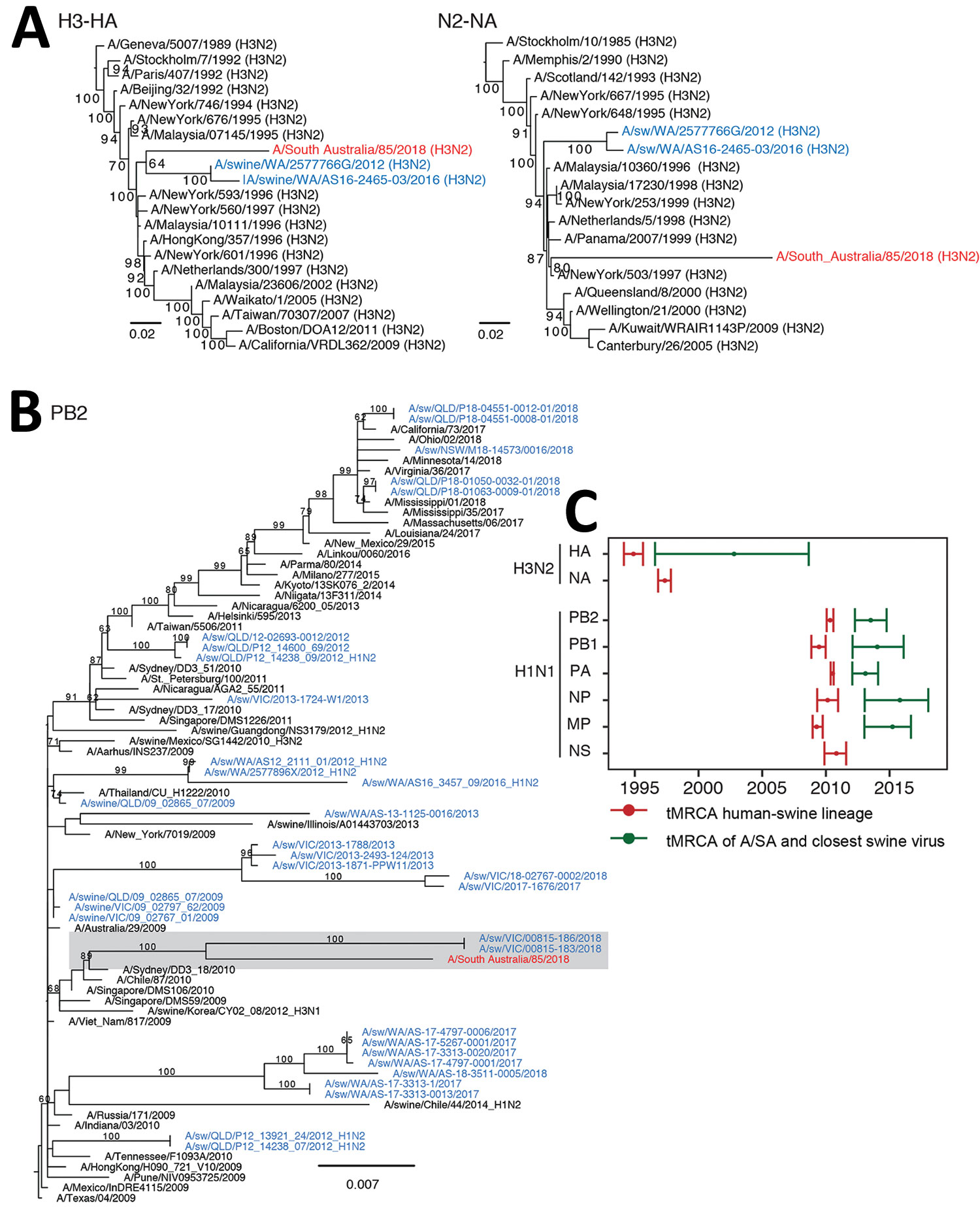Volume 26, Number 1—January 2020
Dispatch
Locally Acquired Human Infection with Swine-Origin Influenza A(H3N2) Variant Virus, Australia, 2018
Figure 1

Figure 1. Genetic origin of influenza A/South Australia/85/2018 virus isolated from a human patient in Australia (red) from swine influenza A(H3N2) and H1N1pdm09 viruses. Blue indicates influenza A viruses from swine in Australia. A, B) Maximum-likelihood phylogenies estimated by using RAxML version 8 (10) of the HA and NA genes (A) and PB2 gene (B) showing bootstrap values at branch nodes (Appendix). The origins of the remaining 5 internal proteins genes (PB1, PA, NP, MP, and NS) are provided in Appendix Figure 2, and the GenBank accession numbers and dates of sampling are provided in Appendix Table 4. Scale bars indicate nucleotide substitutions per site. C) Calculation of tMRCA. Red indicates means and 95% CIs of the time of origin of each of the Australia swine influenza A virus lineages from human seasonal influenza viruses. Numbers denote viruses that shared the same tMRCA and that formed a similar lineage. Green indicates the time of divergence of A/South Australia/85/2018 from A/swine/WA/2577766G/2012 (H3N2) (for the H3 HA gene) and A/swine/Victoria/18-04095-0003/2018 (H1N1) (for 5 internal protein genes: PB2, PB1, PA, NP, and MP). N2 and NS proteins of A/South Australia/85/2018 are directly derived from human viruses. Divergence times were estimated by using the uncorrelated log-normal relaxed clock model (11) in a Bayesian Markov chain Monte Carlo framework in BEAST version 1.10 (https://beast.community). A/SA, A/South Australia/85/2018 virus; HA, hemagglutinin; MP, matrix protein; NA, neuraminidase; NP, nucleoprotein; NS, nonstructural; PA, polymerase acidic; PB, polymerase basic; A(H1N1)pdm09 virus, 2009 pandemic influenza H1N1 virus; tMRCA, time to most recent common ancestor.
References
- Smith GJ, Vijaykrishna D, Bahl J, Lycett SJ, Worobey M, Pybus OG, et al. Origins and evolutionary genomics of the 2009 swine-origin H1N1 influenza A epidemic. Nature. 2009;459:1122–5. DOIPubMedGoogle Scholar
- Dawood FS, Jain S, Finelli L, Shaw MW, Lindstrom S, Garten RJ, et al.; Novel Swine-Origin Influenza A (H1N1) Virus Investigation Team. Emergence of a novel swine-origin influenza A (H1N1) virus in humans. N Engl J Med. 2009;360:2605–15. DOIPubMedGoogle Scholar
- Vincent A, Awada L, Brown I, Chen H, Claes F, Dauphin G, et al. Review of influenza A virus in swine worldwide: a call for increased surveillance and research. Zoonoses Public Health. 2014;61:4–17. DOIPubMedGoogle Scholar
- Bowman AS, Nelson SW, Page SL, Nolting JM, Killian ML, Sreevatsan S, et al. Swine-to-human transmission of influenza A(H3N2) virus at agricultural fairs, Ohio, USA, 2012. Emerg Infect Dis. 2014;20:1472–80. DOIPubMedGoogle Scholar
- Centers for Disease Control and Prevention (CDC). Influenza A (H3N2) variant virus-related hospitalizations: Ohio, 2012. MMWR Morb Mortal Wkly Rep. 2012;61:764–7.PubMedGoogle Scholar
- Wong FYK, Donato C, Deng YM, Teng D, Komadina N, Baas C, et al. Divergent human-origin influenza viruses detected in Australian swine populations. J Virol. 2018;92:e00316–8. DOIPubMedGoogle Scholar
- Matrosovich M, Matrosovich T, Carr J, Roberts NA, Klenk HD. Overexpression of the alpha-2,6-sialyltransferase in MDCK cells increases influenza virus sensitivity to neuraminidase inhibitors. J Virol. 2003;77:8418–25. DOIPubMedGoogle Scholar
- Hayden FG, Hay AJ. Emergence and transmission of influenza A viruses resistant to amantadine and rimantadine. Curr Top Microbiol Immunol. 1992;176:119–30. DOIPubMedGoogle Scholar
- Deng YM, Iannello P, Smith I, Watson J, Barr IG, Daniels P, et al. Transmission of influenza A(H1N1) 2009 pandemic viruses in Australian swine. Influenza Other Respir Viruses. 2012;6:e42–7. DOIPubMedGoogle Scholar
- Stamatakis A. RAxML version 8: a tool for phylogenetic analysis and post-analysis of large phylogenies. Bioinformatics. 2014;30:1312–3. DOIPubMedGoogle Scholar
- Drummond AJ, Ho SY, Phillips MJ, Rambaut A. Relaxed phylogenetics and dating with confidence. PLoS Biol. 2006;4:
e88 . DOIPubMedGoogle Scholar - Duwell MM, Blythe D, Radebaugh MW, Kough EM, Bachaus B, Crum DA, et al. Influenza A(H3N2) variant virus outbreak at three fairs —Maryland, 2017. MMWR Morb Mortal Wkly Rep. 2018;67:1169–73. DOIPubMedGoogle Scholar
- Epperson S, Jhung M, Richards S, Quinlisk P, Ball L, Moll M, et al.; Influenza A (H3N2)v Virus Investigation Team. Human infections with influenza A(H3N2) variant virus in the United States, 2011-2012. Clin Infect Dis. 2013;57(Suppl 1):S4–11. DOIPubMedGoogle Scholar
- Jhung MA, Epperson S, Biggerstaff M, Allen D, Balish A, Barnes N, et al. Outbreak of variant influenza A(H3N2) virus in the United States. Clin Infect Dis. 2013;57:1703–12. DOIPubMedGoogle Scholar
- Animal Health Australia. AUSVETPLAN manuals and documents. Influenza A viruses in swine (Version 4.0) [cited 2019 Jul 5]. https://www.animalhealthaustralia.com.au/our-publications/ausvetplan-manuals-and-documents